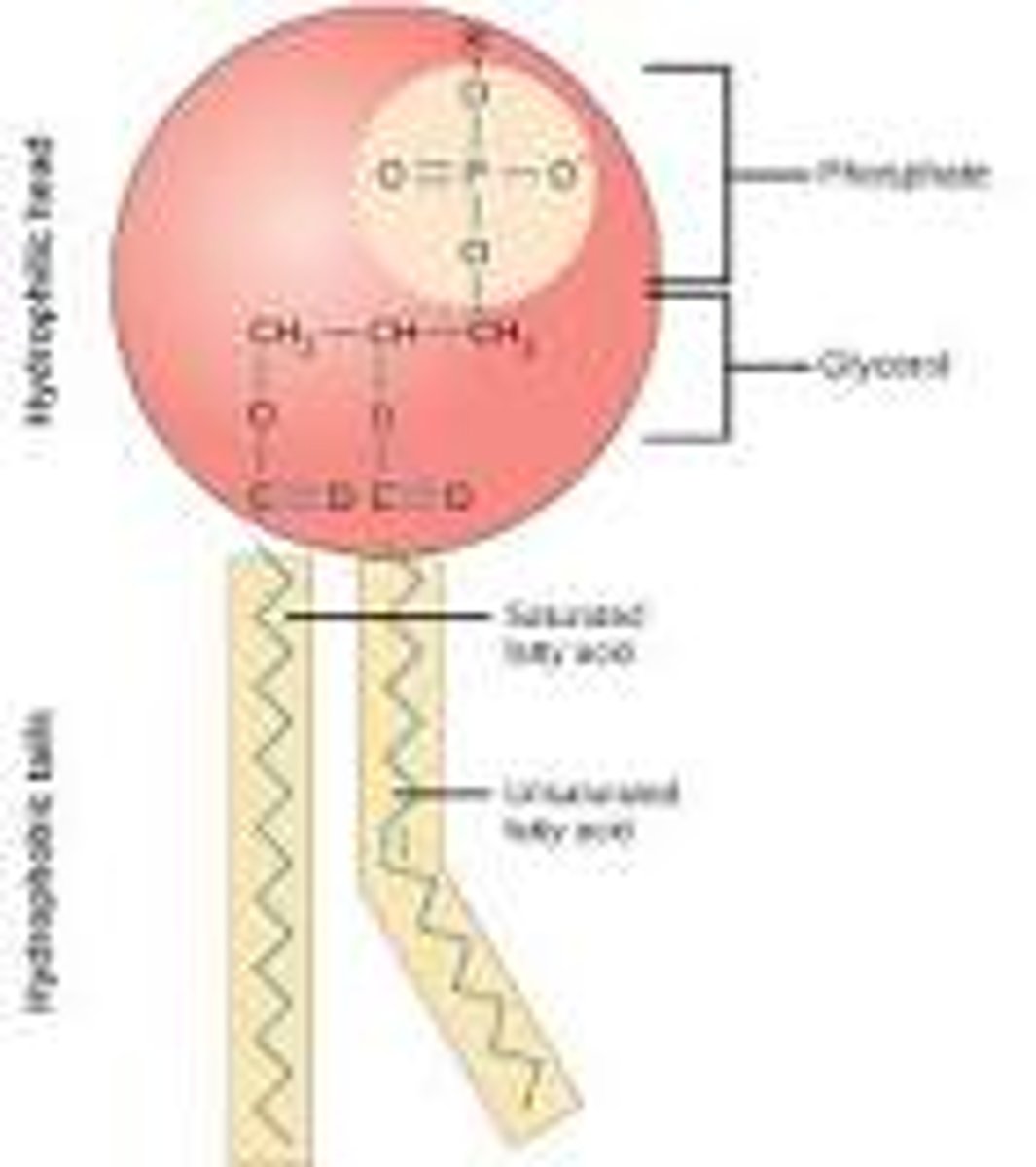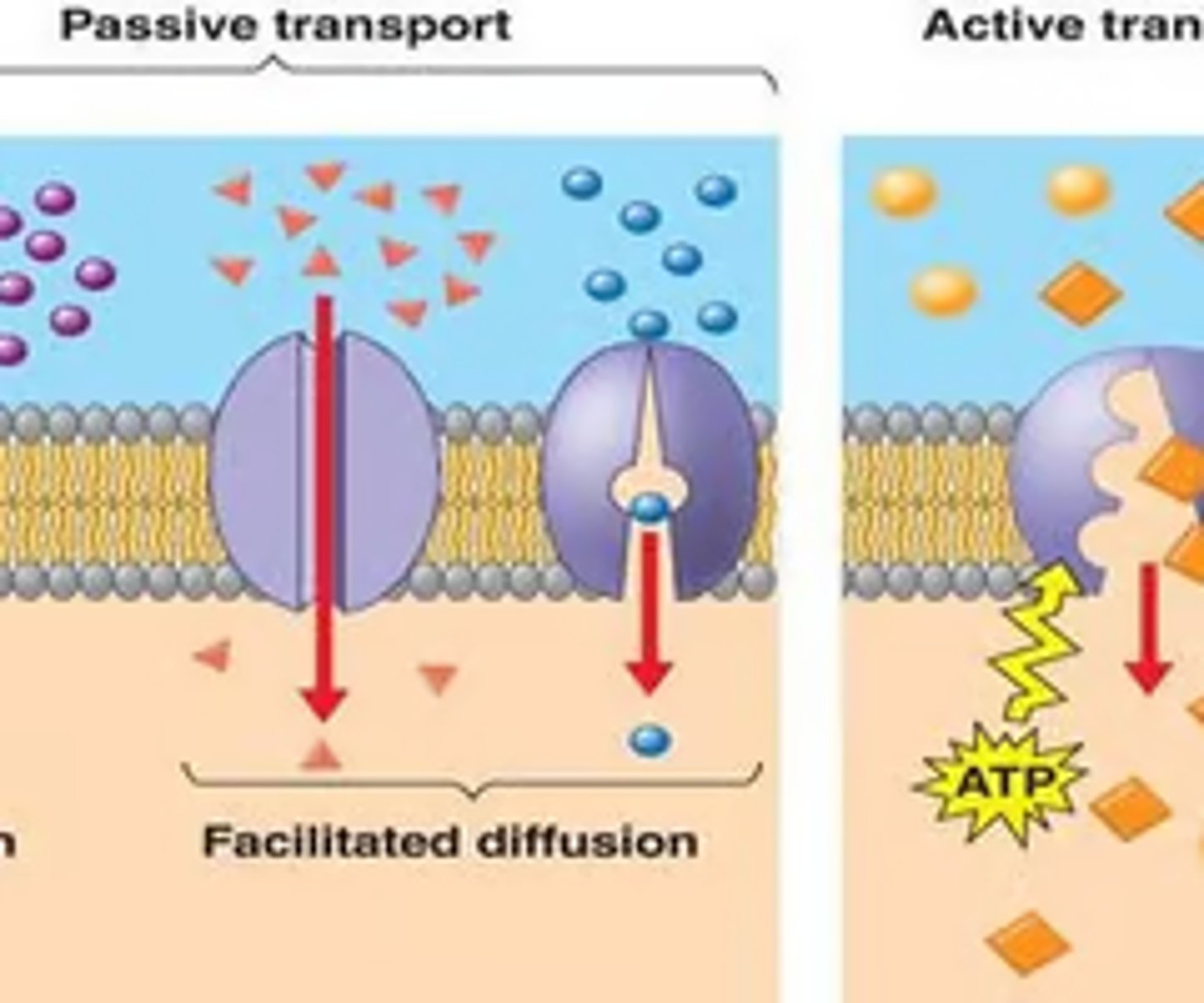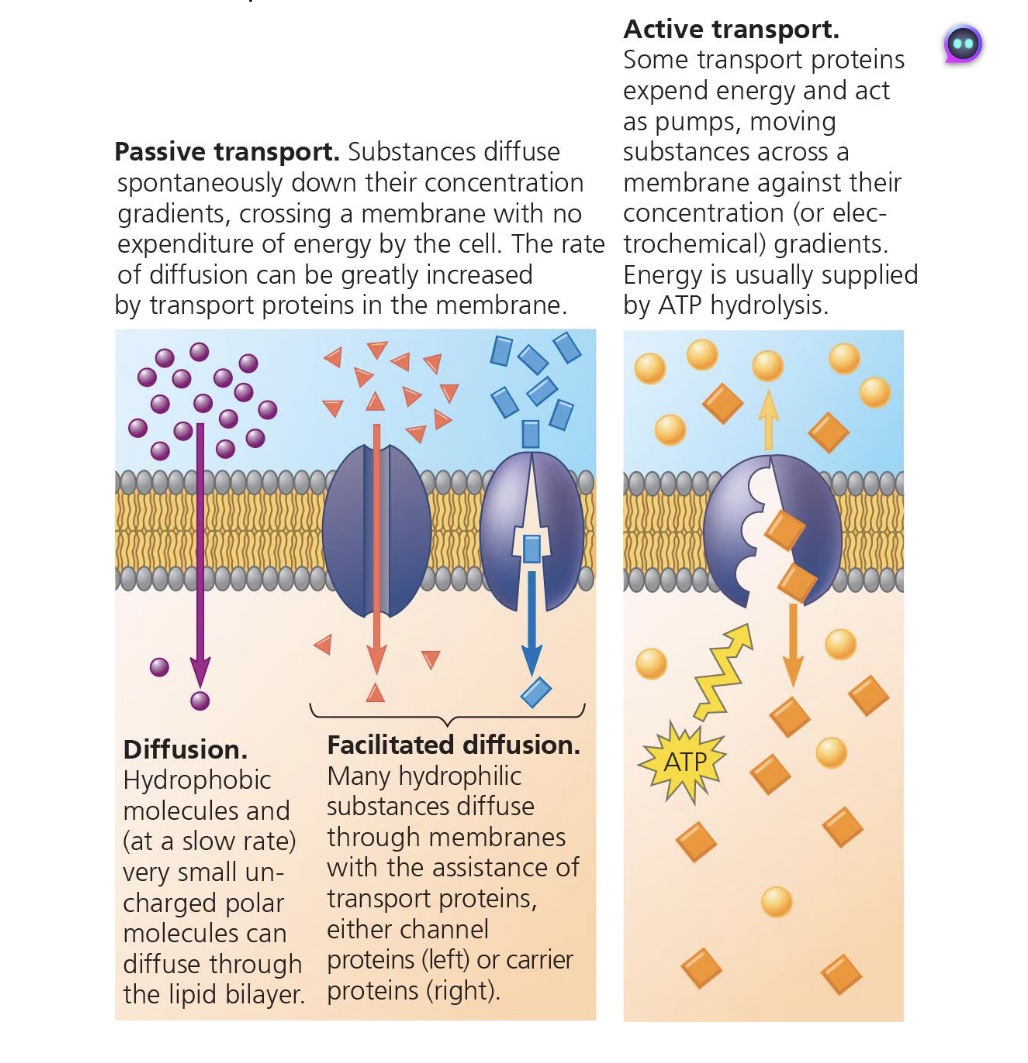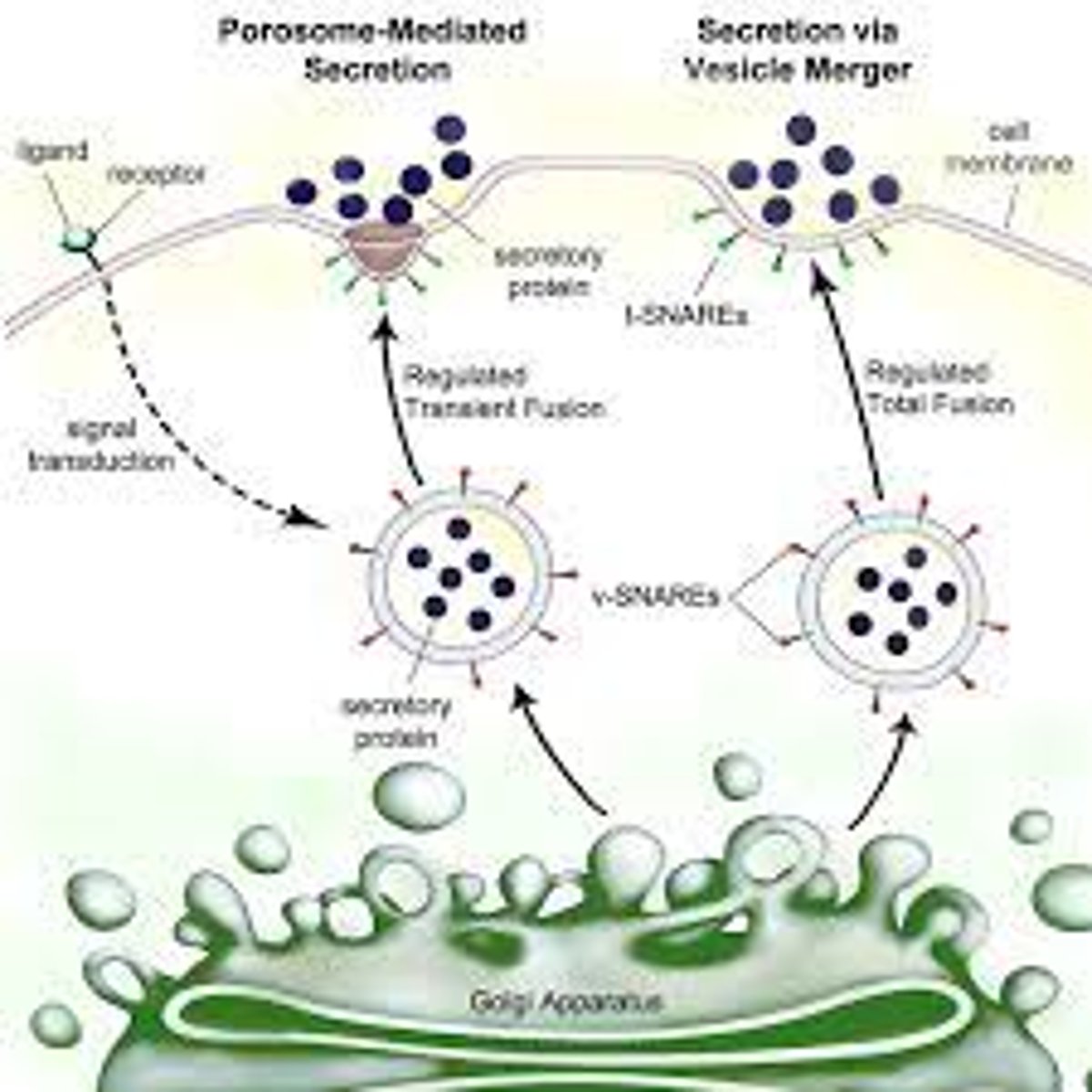Biology chapter 7 Membranes
1/22
There's no tags or description
Looks like no tags are added yet.
Name | Mastery | Learn | Test | Matching | Spaced |
|---|
No study sessions yet.
23 Terms
Discuss why membranes are important to a living cell.
-A boundary that allows for protection
-Regulation of what enters and exist
-Allows for pH regulation
-Cell binding
-Cell recognition
-ionic exchange and osmotic pressure
-transport nutrient's and proteins in and out of the cell.
Be able to state the two main classes of biomolecules that constitute membranes in living cells.
Lipids and proteins(specifically phospholipids); Proteins: channel, integral, peripheral, and carrier all all proteins that exist on the plasma membrane.
Be able to explain why the model for biological membranes is referred to as fluid mosaic model.
plasma membrane composed of fluid bi-layer and has many deferent colorful and random parts working together to form a beautifull cell like a mosaic.
The cell membrane is made of different parts working together, like a mosaic is made of many tiles.
The "mosaic" term refers to the mixture of lipids and intrinsic proteins in the membrane.
What is the nature of the interaction that holds together a bilayer?
Hydrophobic interaction cause lose bond to form on the inner portion of the bilayer.
Specifically van der Waals forces hold the hydrophobic tails together.
Hydrogen bonds causes the hydrophilic heads to bond together due to the Prescence of water.
Be able to explain the structure of phospholipids. Which region of such a molecule hydrophobic and which region is hydrophilic?
Contains a glycerol head but instead of the third OH group containing a fatty acid tail it is attached to a phosphate group.
One tail has a bend this is what prevents the membrane from packing very tightly.
The tails are hydrophobic because of how non polar they are due to the hydrocarbons they posses.
Heads are hydrophilic due the phosphate group being negatively charged.

Be able to explain the dual property of a membrane protein and the property of the regions of a protein that is present within the bilayer and the property of regions of a protein that is facing the extracellular space or the cytosol.
The proteins that are embedded within the bilayer and do not face the outside or extracellular space are hydrophobic and contain nonpolar amino acids. The proteins that do face the extracellular space/cytosol are hydrophilic and they contain either polar or charged amino acids.
Integral proteins
Permanently anchored. They penetrate the hydrophobic interior of the lipid bilayer. The hydrophobic regions consist of one or more stretches of nonploar amino acids, typically 20-30 amino acids in length coiled into helices. The hydrophilic parts of the molecule are exposed to the aqueous solutions on either side of the membrane.
Peripheral proteins
Temporarily attached to the lipid bilayer, or to the other integral proteins. They are not embedded in the lipid bilayer; they are loosely bound to the surface of the membrane, often to exposed parts of integral proteins.
How does the primary structure of a protein determine its position in the membrane?
The structure of a protein is determined by the sequence of its amino acids. The location of the protein is ultimately determined by its hydrophilic region and the folding it determined by the environment in which the protein is present.
What are different functions known for membrane proteins?
Enzymatic function
signal transduction
transportation
Attachment
Intercellular joining
Be able to explain the selective permeability of biological membranes.
Only small hydrophobic molecules are able to pass through the phospholipid membrane with ease. However bigger molecules cannot squeeze through them and need the assistance of proteins which is why it is called selectively permeable. H2O and small non polar molecules can pass through without facilitated diffusion.
Be able to explain the extent to which the following can cross pure phospholipid bilayers:
Small nonpolar molecules (give some examples)
Small polar molecules(examples)
Large polar molecules (examples)
Charged substances (examples)
Small non polar: O2 and CO2 and ammonium and Nitrate can pass through the membrane rapidly
Small polar molecules: H2O. does not cross rapidly relative to nonpolar molecules
Large polar molecules cannot cross through the plasma membrane
Charged substances cannot cross a lipid bilayer at all.
Name the two kinds of transport across biological membranes and what is the physical/ chemical basis of transport for each kind.
Simple diffusion and facilitated diffusion.
Simple is essentially the movement of molecules down the concentration gradient so energy is not required.
Facilitated diffusion is movement of molecules up the concentration gradient which requires assistance of ATP molecules
Be able to state kinds of molecules, cells need from their environment and the kind of molecules they discard to the outside across their membranes.
Need molecules such and O2 and glucose C6H12O6
Discard lactic acid, lactose, hydrogen, and ethanol C2H5OH as well as CO2
Explain passive transport across a membrane.
Although no additional energy needs to be supplied, work involved in passive transport is possible due to the ____________________ associated with the concentration gradient.
The diffusion of a substance across a biological membrane with no energy required.
Molecules wants to be at equilibrium when there is a imbalance in concentration gradient which is why they will move to hypotonic area such as inside or outside a cell.
imbalance.
Name the two kinds of passive transport. What is the nature of the molecules that undergo simple diffusion?
Osmosis and diffusion.
Size: They are small
Charge: They are uncharged
Solubility: They are lipid-soluble
Surface area: They have a small surface area
Examples of molecules that undergo simple diffusion include: Oxygen, Carbon dioxide, Ethanol
What is facilitated diffusion and what are the two different kinds of membrane proteins that help in facilitated diffusion? Is facilitated diffusion specific or non-specific?
Facilitated diffusion is the movement of down the concentration gradient with the assistance of carriers. Channel proteins and carrier proteins assist in this process.
Facilitated diffusion is specific as the proteins usually only let one or small number of molecules through.
What is the basic difference between the two kinds of facilitated diffusion? (eg one kind creates passage, through which thousands in numbers of the specific molecules may pass through, whereas in the other case each molecule that is transported binds to a protein specifically and ....................) Which of the above two classes do Aquaporins belong to?
channel proteins exist usually for one or a very small amount of molecules. This is ultimately a hydrophilic channel that allows molecules to enter and leave the cell.
Carrier proteins can exist as integral and peripheral. These molecules can bind to a molecules based on size and change shape to allow the molecules to pass through the bilayer. THey usually allow any molecue of the appropriate size through.

How is glucose transported by passive transport from cells (eg intestinal cells, liver cells) that have a higher concentration into the blood stream so that all other cells (especially neurons/brain cells) may use it? Are amino acids transported by such mechanisms?
Carrier proteins are responsible for the facilitated diffusion of sugars, amino acids, and nucleotides across the plasma membranes of most cells. Glut4
Yes because these molecules
Be able to explain the salient features of active transport that differentiate it from passive transport (concentration gradient related, energy requirement, involvement of proteins with specific properties).
passive transport does not require energy. It is the movement down the concentration gradient and can use or not use proteins.
Active transport requires ATP to change the structure of the binding site. They only use carrier proteins no channel ones and are the movement of molecules up the concentration gradient which only carrier proteins can do.
Be able to explain the two different kinds of Active transport. In which case is the hydrolysis of ATP used to do the work of transport? In which case, is the potential energy of a preexisting gradient of ions used to carry out the work of transportation of a second molecule.
primary or secondary. A primary active transport is one that uses chemical energy in the form of ATP
whereas a secondary active transport uses potential energy often from an electrochemical potential difference.
Sodium-potassium pump
ATP can power active transport by transferring a phosphate group from ATP (forming ADP) to the transport protein.
Since K+ concentration is greater in cell and lower out and Na+ concentration is lower in the cell and greater out of the cell the cell uses this difference to pup out three Na+ ions and take in 2 K+ ions.
Be able to draw a summary diagram illustrating the essential features of different kinds of passive transport and active transport. Given such a figure be able to choose the right transport process.

Explain the steps in secretion, starting from the ER all the way to the plasma membrane.
The secretory pathway occurs in a vectorial manner and begins with uptake of amino acids that are used by the rough endoplasmic reticulum to produce newly synthesized proteins. These new proteins are transported to the Golgi complex for further processing and sorting. Proteins exit the Golgi complex in membrane-bound condensing vacuoles. As these vacuoles mature to secretory granules, they bud off from the membrane and the proteins stored inside are posttranslationally modified prior to exocytosis (Castle, 1993; Marino and Gorelick, 2009). As the proteins move through each of the stages of the secretory pathway toward the apical surface, they become more concentrated. Granules then dock and fuse with the apical membrane, which is mediated by SNARE proteins
